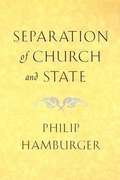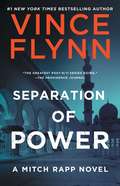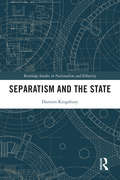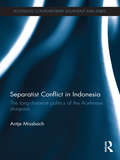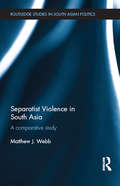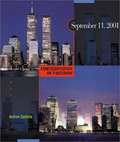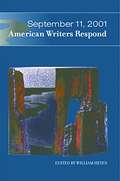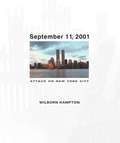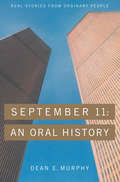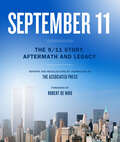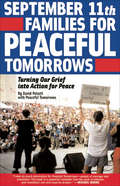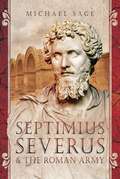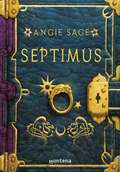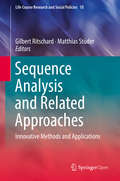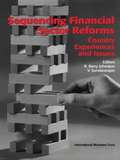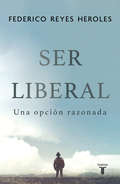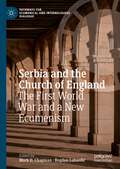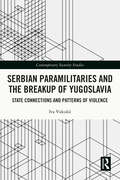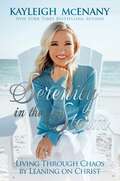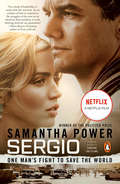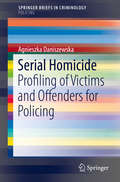- Table View
- List View
Separation Of Church And State (Revised Edition)
by Philip HamburgerIn a powerful challenge to conventional wisdom, Philip Hamburger argues that the separation of church and state has no historical foundation in the First Amendment. The detailed evidence assembled here shows that eighteenth-century Americans almost never invoked this principle. Although Thomas Jefferson and others retrospectively claimed that the First Amendment separated church and state, separation became part of American constitutional law only much later. In a powerful challenge to conventional wisdom, Philip Hamburger argues that the separation of church and state has no historical foundation in the First Amendment. The detailed evidence assembled here shows that eighteenth-century Americans almost never invoked this principle. Although Thomas Jefferson and others retrospectively claimed that the First Amendment separated church and state, separation became part of American constitutional law only much later. <p><p> Hamburger shows that separation became a constitutional freedom largely through fear and prejudice. Jefferson supported separation out of hostility to the Federalist clergy of New England. Nativist Protestants (ranging from nineteenth-century Know Nothings to twentieth-century members of the K.K.K.) adopted the principle of separation to restrict the role of Catholics in public life. Gradually, these Protestants were joined by theologically liberal, anti-Christian secularists, who hoped that separation would limit Christianity and all other distinct religions. Eventually, a wide range of men and women called for separation. Almost all of these Americans feared ecclesiastical authority, particularly that of the Catholic Church, and, in response to their fears, they increasingly perceived religious liberty to require a separation of church from state. American religious liberty was thus redefined and even transformed. In the process, the First Amendment was often used as an instrument of intolerance and discrimination.
Separation of Power: Separation Of Power, Executive Power, And Memorial Day (A Mitch Rapp Novel #5)
by Vince FlynnThe #1 New York Times bestselling author of the electrifying Mitch Rapp series &“knows how deliver action in his novels&” (St. Paul Pioneer Press) and does so again with this thrilling follow-up to The Third Option. The confirmation of Dr. Irene Kennedy as the CIA&’s new director explodes into chaos as a deadly inside plot to destroy her and prematurely end the president&’s term emerges. Meanwhile, a dangerous world leader gains power in the nuclear arms race, leading Israel to force the president&’s hand with a chilling ultimatum. With the specter of World War III looming, the president calls on top counterterrorism operative Mitch Rapp, but with only two weeks to take out the nukes, Rapp is up against a ticking clock—and impossible odds.
Separation of Powers and Legislative Organization
by Gisela SinThis book examines how the constitutional requirements of the lawmaking process, combined with the factional divisions within parties, affect U. S. representatives' decisions about how to distribute power among themselves. The incorporation of the presidential, senatorial, and House factions in the analysis of House rule making marks an important departure from previous theories, which analyze the House as an institution that makes laws in isolation. This book argues that, by constitutional design, the success of the House in passing legislation is highly contingent on the actions of the Senate and the president; and therefore, also by constitutional design, House members must anticipate such actions when they design their rules. An examination of major rule changes from 1879 to 2013 finds that changes in the preferences of constitutional actors outside the House, as well as the political alignment of these political actors vis-. . . -vis House factions, are crucial for predicting the timing and directionality of rule changes.
Separatism and the State (Routledge Studies in Nationalism and Ethnicity)
by Damien KingsburyThis book proposes and tests a ‘theory of separatism’ to determine if there are key commonalities as to why separatist movements rise and what fuels them. In the post-Cold War period separatism has been on the rise. Today, there are more than 100 active separatist movements, with around 70 of them engaging in violence. This book focuses on examples from Europe, the Middle East, Africa, and Asia to highlight the commonalities found across the case studies. It examines the idea of separatism, to better understand what drives movements to break away from pre-existing states; demonstrates the factors which produce both violent separatism and the rise of armed non-state actors; and shows the options for the resolution of such conflict, based on considering claims for separatism from the perspectives of separatist movements. This book will be applicable for undergraduate and postgraduate students of International Relations and International Politics as well as Conflict/Peace Studies, Anthropology and Post-Colonial Studies.
Separatist Conflict in Indonesia: The long-distance politics of the Acehnese diaspora (Routledge Contemporary Southeast Asia Series)
by Antje MissbachThe socio-political activities of the Acehnese diaspora, located mainly in Malaysia, Scandinavia, the USA and Australia, have been of fundamental importance to conflict and politics within Aceh. The intensity of the relations between the diaspora and the homeland was mainly determined by the conflict that afflicted the region between 1976 and 2005, and the resulting hardship was experienced by Acehnese both at home and abroad. This book looks at more than thirty years of long-distance politics exercised by the Acehnese diaspora both during the conflict and beyond. It interprets the social, political and cultural aspects of the small-scale conflict in Aceh, as well as focusing on the external factors related to the Acehnese overseas and their impact on homeland politics. The book goes on to contribute to the argument that the Acehnese diaspora had a significant impact on those who remained in Aceh. By focusing on the triangular relationships between the homeland, the host countries and the Acehnese diaspora, the book draws attention to the exchange of people, ideas, and financial and material resources that has occurred. It is a useful contribution to Southeast Asian Politics and Diaspora Studies.
Separatist Violence in South Asia: A comparative study (Routledge Studies in South Asian Politics)
by Matthew J. WebbSince decolonization began in the late 1940s, a series of often lengthy and destructive separatist insurgencies have imposed severe financial, economic and human costs upon the states of South Asia. Whereas previous analyses of these conflicts have typically focussed upon the parent state or separatist group as the relevant unit of analysis, this book adopts a broader framework, arguing that separatism cannot be understood in isolation from the concept of state sovereignty. This book explores the motives, tactics, successes and failures of South Asia’s separatist movements by deconstructing sovereignty into its constituent components and offers an explanation for why separatism, but not political violence, has recently declined in the region. Taking a comparative explanatory viewpoint, it offers a comprehensive review of relevant explanatory theories dominant in the scholarly literature on separatism and an examination of their application to the South Asian states of India, Pakistan, Sri Lanka and Bangladesh. As a thought-provoking discussion of statehood and sovereignty, this book will be of interest to students of political theory, comparative politics, international relations and South Asian politics.
September 11 in History: A Watershed Moment?
by Mary L. DudziakHours after the collapse of the Twin Towers, the idea that the September 11 attacks had "changed everything" permeated American popular and political discussion. In the period since then, the events of September 11 have been used to justify profound changes in U. S. public policy and foreign relations. Bringing together leading scholars of history, law, literature, and Islam, September 11 in History asks whether the attacks and their aftermath truly marked a transition in U. S. and world history or whether they are best understood in the context of pre-existing historical trajectories. From a variety of perspectives, the contributors to this collection scrutinize claims about September 11, in terms of both their historical validity and their consequences. Essays range from an analysis of terms like "ground zero," "homeland," and "the axis of evil" to an argument that the U. S. naval base at Guantnamo Bay has become a site for acting out a repressed imperial history. Examining the effect of the attacks on Islamic self-identity, one contributor argues that Osama bin Laden enacted an interpretation of Islam on September 11 and asserts that progressive Muslims must respond to it. Other essays focus on the deployment of Orientalist tropes in categorizations of those who "look Middle Eastern," the blurring of domestic and international law evident in a number of legal developments including the use of military tribunals to prosecute suspected terrorists, and the justifications for and consequences of American unilateralism. This collection ultimately reveals that everything did not change on September 11, 2001, but that some foundations of democratic legitimacy have been significantly eroded by claims that it did. Contributors Khaled Abou el Fadl Mary L. Dudziak Christopher L. Eisgruber Laurence R. Helfer Sherman A. Jackson Amy B. Kaplan Elaine Tyler May Lawrence G. Sager Ruti G. Teitel Leti Volpp Marilyn B. Young
September 11, 2001 (Cornerstones of Freedom, 2nd Series)
by Andrew SantellaThe events of September 11, 2001, shocked and horrified Americans. They served as a reminder that even a nation as mighty as the United States must always be prepared to defend itself. The book tells us the series of events of that fateful day.
September 11, 2001: American Writers Respond
by William HeyenThis book, which is unlike any other in our literature, was written during the three months following September 11, 2001. There are more than 125 fiction writers, poets, and essayists who have given their contributions to the book.
September 11, 2001: Attack on New York City
by Wilborn HamptonThe award-winning Wilborn Hampton recounts one horrifying day in history through the eyes of several who experienced it firsthand. A blind man and his dog struggling to escape from the burning North Tower, a company of firefighters risking their lives to help with the evacuation, an ordinary citizen turned rescue worker sifting through debris after the towers collapsed - each of these individuals endured a personal nightmare, and each carries a separate memory. In SEPTEMBER 11, 2001: ATTACK ON NEW YORK CITY, Wilborn Hampton captures an unprecedented piece of history through interviews and accounts of survivors, heroes, and terrorists. In addition, the seasoned reporter tells his own story, thus bringing to readers the grieving, compassionate voice of a fellow New Yorker who was close to Ground Zero. Amplifying the narrative are fifty-four black-and-white photographs, indelible images of horror and heroism unfolding. The panorama of views Wilborn Hampton presents, following several individuals through September 11 and its aftermath, creates an intimate portrait of life and loss, and a deeper understanding of the events of that tragic day.
September 11: An Oral History
by Dean MurphyAbout 3,000 people lost their lives in the terrorist attacks on New York City and Washington, D.C., on September 11, 2001. Thousands more narrowly escaped, their survival a result of eerily prescient spur-of-the-moment decisions, acts of superhuman courage, the unfailing kindness of strangers, and, in some cases, fortuitous strokes of luck. September 11: An Oral History unites the voices of that day. It is at once a dramatic reminder of one of the most devastating events in history of the nation and a tribute to the spirit of cooperation and the outpourings of empathy that marked that day for so many people in the United States and abrad. Written and compiled by Dean E. Murphy, who covered the attacks on the World Trade Center for the New York Times, September 11: An Oral History presents vivid eyewitness accounts by those who rushed to the scene, as well as the stories of people around the country and abroad who watched as events unfolded on television and waited for news of friends, family, and acquaintances.A priest who runs an adoption center near the WTC paints an unforgettable portrait of what he calls "the meeting place of Hell and Earth that morning"; a businessman from Los Angeles in New York to conduct a training seminar recounts in breathstopping detail his descent with a blind colleague from the 78th floor of the North Tower; a senior at a high school; the owners of a small business in Arkansas describe their thoughts and feelings as they waited to hear from a customer who had become part of their lives though they had never actually met him; and a civilian employee at the Pentagon recalls giving up hope in a smoke-filled office, her hair on fire, only to be led to safety by the soothing voice of a colleague. Contributions from firefighters, police, and military personnel, and other rescue workers demonstrate the mixture of professionalism and humanity that justly elevated them, despite their own modesty, to the status of national heroes. There are stories, too, of those who narrowly missed being part of the mayhem--including a family of four who changed their plane reservations from one of the hijacked jets and others whose arrivals at work were delayed by unlikely coincidences and quirks of fate like forgetting to turn on the coffeepot the night before.The first and only oral history of September 11 that presents people from all walks of life, these poignant, often harrowing vignettes capture the grief, rage, and fear that gripped the nationj--and offer an intimate, inspiring look at the strengths that enabled us to move on.From the Hardcover edition.
September 11: The 9/11 Story, Aftermath and Legacy
by The Associated PressA commemoration of the 20th anniversary of 9/11 as told through stories and photographs from The Associated Press—covering everything from the events of that tragic day to the rebuilding of the World Trade Center and beyond.This important and comprehensive book commemorates the 20th anniversary of September 11 as told through stories and images from the correspondents and photographers of The Associated Press—breaking news reports, in-depth investigative pieces, human interest accounts, approximately 175 dramatic and moving photos, and first-person recollections. AP&’s reporting of the world-changing events of 9/11; the heroic rescue efforts and aftermath; the world&’s reaction; Operation Enduring Freedom; the continuing legal proceedings; the building of the National September 11 Memorial & Museum in New York City as a place of remembrance; the rebuilding of downtown NYC and much more is covered. Also included is a foreword by Robert De Niro. The book tells the many stories of 9/11—not only of the unprecedented horror of that September morning, but also of the inspiring resilience and hope of the human spirit.
September 11th Families for Peaceful Tomorrows: Turning Tragedy into Hope for a Better World
by David Potorti Peaceful TomorrowsThe true story of a group of people devastated by loss—and inspired to save others from the same heartbreak: &“Very personal and moving accounts.&”—Publishers Weekly Told through essays and correspondence, this is the tale of Peaceful Tomorrows—an anti-war organization made up of survivors of the 9/11 attacks as well as friends and family members of those who died that day. In the midst of shock, rage, and a rush to war, these are people who, though they had every reason for anger, consciously chose a different path—persisting even as others accused them of naiveté, cowardice, or a lack of patriotism. In the hope of sparing others from the suffering they had endured, they protested the dropping of bombs on civilians in Afghanistan and Iraq, and advocated for nonviolent solutions to the problem of terrorism—to seek justice and problem-solving rather than a cycle of retaliation—and were twice nominated for the Nobel Peace Prize. This is their remarkable story.
September 12th: We Knew Everything Would Be All Right
by First-grade students of H. Byron Masterson Elementary in Kennett MissouriA class of first-grade students react to and interpret the events of September 11th, 2001. Their reactions were based on those of their parents and teachers. Although safety was a concern of the students at the beginning, their parents' and teachers' positive attitudes were key to the students' comfort levels and attitudes. Written and illustrated by the first-grade students.
Septimius Severus & the Roman Army
by Michael SageA detailed account of Severus&’ reign with particular emphasis on his military campaigns against the Parthians and the Garamantes in North Africa. The assassination of Emperor Commodus in 192 sparked a civil war. Septimius Severus emerged as the eventual victor and his dynasty (the Severans) ruled until 235. He fought numerous campaigns, against both internal rivals and external enemies, extending the Empire to the east (adding Mesopotamia), the south (in Africa) and the north (beyond Hadrian&’s Wall). The military aspects of his reign, including his reforms of the army, are the main focus of this new study. After discussing his early career and governorship of Pannonia, Michael Sage narrates his war with Pescennius Niger, the siege of Byzantium, and the campaign in northern Mesopotamia that added it as a province. The much more difficult campaign against Clodius Albinus in Gaul is also studied in detail, as is that in North Africa. The narrative concludes with an account of the last campaign in Britain and Severus&’ death. The final chapters analyze Septimius&’ reforms of the army and assess their impact on events of the next seventy years until the accession of Diocletian. His greatest weakness was his love for his family. Like Marcus Aurelius he loved his children too much. They failed to maintain what he had bequeathed them.&“Sage performs a masterful job putting Severus into a broad strategic overview of the times.&” —The Historical Miniatures Gaming Society&“Highly recommended to fans of the Roman Empire, and of the Roman Military, old and new alike. It is easily accessible and well written, and it features research of the highest quality.&” —Ancient Warfare
Septimus
by Angie SageSolo necesita dos cosas: matar a la princesa y robar el amuleto Akhenaten de Marcia, la Maga ExtraOrdinaria. Para conseguir lo primero deberá arrebatarla de la familia Heap, unos magos que la adoptaron nada más nacer, y han mantenido en secreto sus principescos orígenes. Para lo segundo, deberá enfrentarse a Marcia, la Maga ExtraOrdinaria. Tanto los Heap como Marcia huyen a casa de la tía Zelda. Sin embargo, una traición hará que DomDaniel los descubra. Todos juntos deberán unirse si quieren vencerlo y se enfrentarán aun sinfín de peripecias donde caben el humor, la ternura, la más trepidante de las aventuras y, cómo no, la más inesperada sorpresa.
Sequel to Suburbia: Glimpses of America's Post-Suburban Future (Urban and Industrial Environments)
by Nicholas A. PhelpsHow the decentralized, automobile-oriented, and fuel-consuming model of American suburban development might change.In the years after World War II, a distinctly American model for suburban development emerged. The expansive rings of outer suburbs that formed around major cities were decentralized and automobile oriented, an embodiment of America's postwar mass-production, mass-consumption economy. But alternate models for suburbia, including “transit-oriented development,” “smart growth,” and “New Urbanism,” have inspired critiques of suburbanization and experiments in post-suburban ways of living. In Sequel to Suburbia, Nicholas Phelps considers the possible post-suburban future, offering historical and theoretical context as well as case studies of transforming communities.Phelps first locates these outer suburban rings within wider metropolitan spaces, describes the suburbs as a “spatial fix” for the postwar capitalist economy, and examines the political and governmental obstacles to reworking suburban space. He then presents three glimpses of post-suburban America, looking at Kendall-Dadeland (in Miami-Dade County, Florida), Tysons Corner (in Fairfax County, Virginia), and Schaumburg, Illinois (near Chicago). He shows Kendall-Dadeland to be an isolated New Urbanism success; describes the re-planning of Tysons Corner to include a retrofitted central downtown area; and examines Schaumburg's position as a regional capital for Chicago's northwest suburbs. As these cases show, the reworking of suburban space and the accompanying political process will not be left to a small group of architects, planners, and politicians. Post-suburban politics will have to command the approval of the residents of suburbia.
Sequence Analysis and Related Approaches: Innovative Methods and Applications (Life Course Research and Social Policies #10)
by Gilbert Ritschard Matthias StuderThis open access book provides innovative methods and original applications of sequence analysis (SA) and related methods for analysing longitudinal data describing life trajectories such as professional careers, family paths, the succession of health statuses, or the time use. The applications as well as the methodological contributions proposed in this book pay special attention to the combined use of SA and other methods for longitudinal data such as event history analysis, Markov modelling, and sequence network. The methodological contributions in this book include among others original propositions for measuring the precarity of work trajectories, Markov-based methods for clustering sequences, fuzzy and monothetic clustering of sequences, network-based SA, joint use of SA and hidden Markov models, and of SA and survival models. The applications cover the comparison of gendered occupational trajectories in Germany, the study of the changes in women market participation in Denmark, the study of typical day of dual-earner couples in Italy, of mobility patterns in Togo, of internet addiction in Switzerland, and of the quality of employment career after a first unemployment spell. As such this book provides a wealth of information for social scientists interested in quantitative life course analysis, and all those working in sociology, demography, economics, health, psychology, social policy, and statistics.
Sequencing Financial Sector Reforms Country Experiences and Issues
by International Monetary FundA report from the International Monetary Fund.
Ser liberal: Una opción razonada
by Federico Reyes Heroles«Si una persona niega la ciencia y los relevos sucesivos de verdades relativas, estará imposibilitada para comprender la mecánica liberal.»
Serbia and the Church of England: The First World War and a New Ecumenism (Pathways for Ecumenical and Interreligious Dialogue)
by Mark D. Chapman Bogdan LubardićThis book presents the first comprehensive account of the changing ecumenical relationships between Britain and Serbia. While the impetus for the collection is the commemoration of the Serbian seminarians who settled in and around Oxford towards the end of the First World War, the scope is much broader, including detailed accounts of the relationships between the Church of England and Serbia and its Orthodox Church from the middle of the nineteenth century until World War II. It includes studies of leading thinkers from the period, especially the charismatic Nikolaj Velimirović. The contributors use many unpublished resources that reveal the centrality of the churches in promoting the Serbian cause through the course of the First World War and in its aftermath.
Serbian Paramilitaries and the Breakup of Yugoslavia: State Connections and Patterns of Violence (Contemporary Security Studies)
by Iva VukušićThis is the first book to offer a comprehensive analysis of the emergence, nature, and function of Serbian paramilitary units during the breakup of Yugoslavia. It addresses crucial questions pertaining to paramilitarism by using the archives of the International Criminal Tribunal for the former Yugoslavia (ICTY) in The Hague, which conducted dozens of trials relating to paramilitary violence, and records from judicial proceedings in the region. The book discusses how and why certain important paramilitary units emerged, how they functioned and transformed through the decade, what their relationships and entanglements were with the state, the Milošević regime, and organized crime. The study thus investigates interrelated ideological, political, and social factors and processes fuelling paramilitary engagement and assesses the impact of this engagement on victims of paramilitary violence and on the state and society for which the units purportedly fought. It argues that coordinated action by a number of state institutions gave rise to paramilitaries tasked with altering borders while maintaining plausible deniability for the sponsoring regime. The outsourcing of violence by the state to paramilitaries led to a significant weakening of the very state these units and their sponsors swore to protect. The book also analyzes differences between the units and how they attacked civilians, arguing that the different forms of violence stemmed not only from the function they fulfilled for the state but also the ways in which they were set up and operated. The final chapter brings the different strands of the argument together into a coherent whole, suggesting avenues for further research, in the former Yugoslavia and beyond. This book will be of much interest to students of ethnic conflict and civil war, war crimes, Balkan politics and International Relations in general.
Serenity in the Storm: Living Through Chaos by Leaning on Christ
by Kayleigh McEnanyKayleigh McEnany brings to life the key cultural and political issues of our time, from the fall of Afghanistan to the Supreme Court&’s abortion decision, analyzing world events through the lens of faith and providing readers with Serenity in the Storm.Our world, without question, is experiencing aberrational times. The ravages and life-altering realities of COVID-19 that I worked through as White House press secretary were just the start of it. What followed was a series of history-defining events. From the fall of Afghanistan to the nationwide crime wave, we&’ve all endured painful images of death, destruction, and chaos. Meanwhile, radical teachings on gender and race have infiltrated our nation&’s schools, poisoning the minds of our children—all at a time when our country feels more divided than ever before. Along with these twenty-first century realities can come a feeling of despair and discouragement. Indeed, I hear it all the time as I crisscross the country: Americans feel disheartened and seek hope. Serenity in the Storm provides that hope. Despite the challenges we face, there is cause for great optimism for men and women of faith. In Afghanistan, the underground church is thriving. On the key issues of life and liberty, the Supreme Court of the United States has delivered enormous and consequential victories. In our schools, voters have spoken unmistakably against the insidious doctrines of critical race and gender theory. There is no doubt that God is at work as He hears the prayers of the faithful! Taking a similar format to my New York Times bestselling book, For Such a Time as This, I analyze our domestic and international challenges through the lens of faith. Though we have lived through dark times and unsettled waters, the storms we face have prompted many great leaders to rise to the moment and have left a yearning in the human heart for a Savior, Jesus Christ, who is walking alongside us every step of the way.
Sergio: One Man's Fight to Save the World
by Samantha PowerThe inspiring profile of one man's courage and compassion-now a feature documentary from HBO(tm) films In this perfect match of author and subject, Pulitzer Prize-winner Samantha Power tackles the life of Sergio Vieira de Mello, whose work for the U. N. before his 2003 death in Iraq was emblematic of moral struggle on the global stage. Power has drawn on a staggering breadth of research (including 400 interviews) to show us a heroic figure and the conflicts he took on, from Cambodia's Khmer Rouge to the slaughter in Bosnia to the war-torn Middle East. The result is a peerless portrait of humanity and pragmatism, as well as a history of our convulsive age.
Serial Homicide
by Agnieszka DaniszewskaThis Brief provides an overview and history of the definition of serial homicide, from the perspectives of psychology, medicine, criminology and forensics. It reviews research to provide a standard definition of serial homicide (as opposed to multiple or mass homicide), and provide insights on profiles of victims and offenders for police practitioners. It also includes a discussion of the media approach to covering serial homicide. The Brief is divided into four major sections covering: definitions and overview of serial homicide, profiling perpetrators according to different typologies, profiling victims, applied case studies, and recommendations for investigation and prevention. The author's approach is aimed primarily at researchers in police studies, but will be of interest to researchers in related fields such as criminal justice, sociology, psychology, and public policy.
